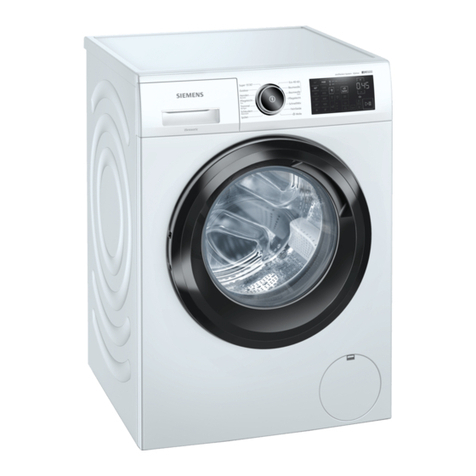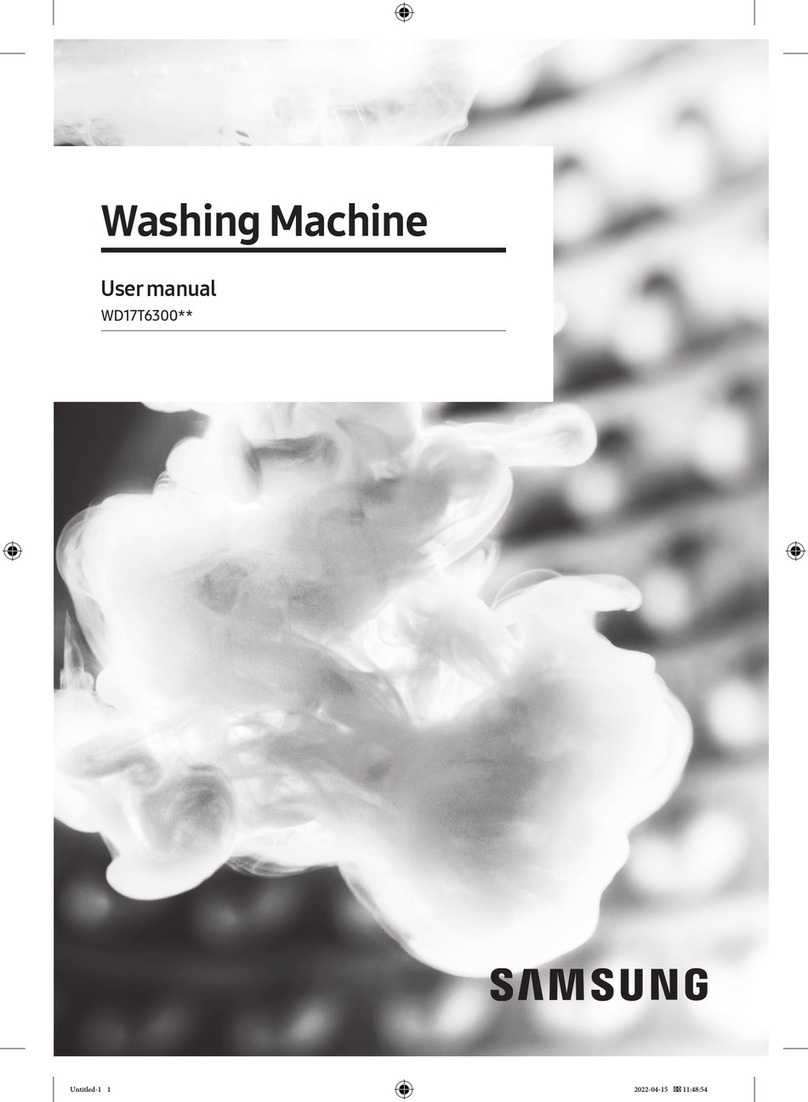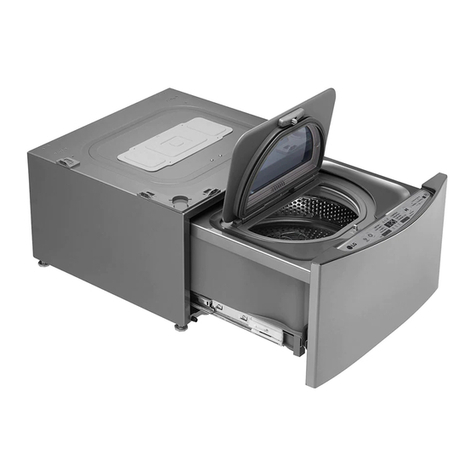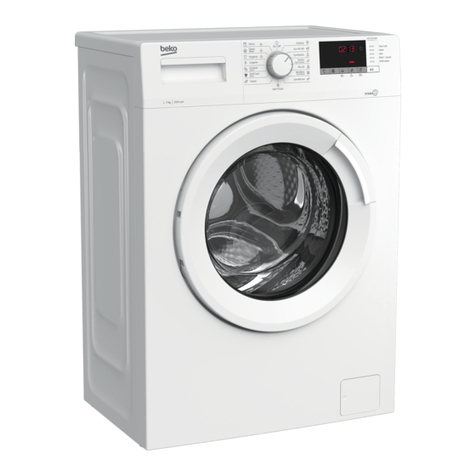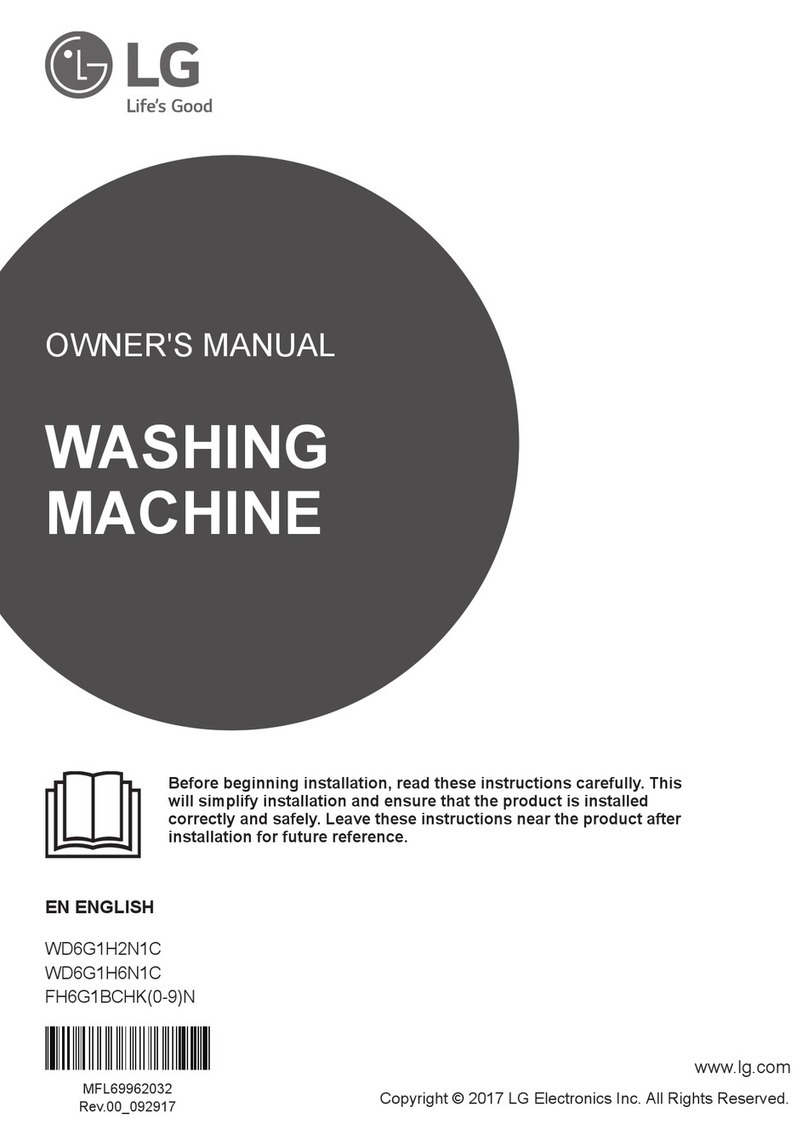Benton Harbor Compact Washer User manual

IMPORTANT:
Read and save
these instructions.
IMPORTANT
Installer: Leave Installation Instructions
with the homeowner,
Homeowner: Keep Installation Instructions
for future reference
Save Installation Instructions for local
electrical inspector’s use.
Compact Washer

Hot and cold water faucets:
Must
be within 4 feet of the back of the
washer and provide water pressure
5-100 PSI.
laundry tub drain system:
Needs a
20-gallon laundry tub. Top of tub
must be at least 27 inches high and
no higher than 48 inches from
bottom of washer.
Before you
start...
Check location where washer
will be installed. Proper
installation is your responsibility.
Make sure you have everything
necessary for correct
installation.
Untape and open washer lid. Remove
packages from washer. Do not
remove hoses or release shipping
straps of ths time. Close and retape lid.
Grounded electrical outlet
is
required. See Electrical
requirements.
Standpipe drain system:
Needs
a two-inch minimum diameter
standpipe with minimum
carry-away
capacity of
17 gallons per
minute. Top of
standpipe must
be at least 34
inches high and
no higher than
72 inches c-+
from bottom
of washer.
If a longer drain hose is needed,
drain hose (Part No. 388423) and
hose extension kit (Par-t No. 285442)
are available from-authorized parts
distributors. If drain hose must be
shortened, use kit (Part No. 285442).
I
Important: Observe all governing
codes and ordinances.
Floor drain
system
requires
a siphon break,
Part No. 285320.
f
Product Damage
Do Not store or operate
washer below 32°F (some
water may remain in
washer).
See Use & Care Guide for
“Winterizing” Information.
Failure to follow above may
result in product damage.
level floor:
Maximum slope
under entire washer-l inch.
SEE
Support:
Floor must be sturdy enough to
support washer weight of 250 pounds.
L
Elect&al Recommended
requbements grounding method
INSTRUCTIONS ON
BACK COVER.
lbols needed for
installation:
For your personal safety, this appliance
must be grounded. This appliance is
equipped with a power supply cord
having a 3-prong grounding plug. To
minimize possible shock hazard, the cord
must be plugged into a mating 3-prong
grounding-type wall receptacle,
grounded in accordance with National
Electrical Code, ANSI/NFPA 70-latest
edition and all local codes and
ordinances, See Figure 1. If a mating
wall receptacle is not available, it is the
personal responsibility and obligation of
the customer to have a properly
grounded 3-prong wall receptacle
installed by a qualified electrician.
Electrical Shock Hazard
l
Electrical ground is required on this
appliance.
l
If cold water pipe is interrupted by
plastic, non-metallic gaskets or other
insulating materials, Do Not use for
grounding.
l
Do Not ground to a gas pipe.
l
Do Not modify the power supply
cord plug. If it does not fit the outlet,
have a proper outlet installed by a
qualified electrician.
l
Do Not have a fuse in the neutral or
grounding circuit. A fuse in the
neutral or grounding circuit could
result in an electrical shock.
. Do Not use an extension cord with
this appliance.
l
Check with a qualified electrician if
you are in doubt as to whether the
appliance is properly grounded.
Failure to follow these instructions
could result in serious injury or death.
utility
knife
Parts supplied for
islstalIation:
Remove parts from packages. Check
that all parts were included.
If codes permit and a separate grounding
wire is used, it is recommended that a
qualified electrician determine that the
grounding path is adequate.
120-Volt, 60-Hz, AC-only, 15- or 20-
ampere fused electrical supply is
required. (Time-delay fuse or circuit
breaker is recommended.) It is
recommended that a separate circuit
serving only this appliance be provided.
U
Power
supply cord
Figure 1
1 small clamp
4 legs with nuts
literature package
1 drain hose
Panel A
1 plastic strap
1 hose clamp
2 inlet hoses
4 flat water hose washers

Now start...
7
Remove yellow card. Take hoses
W out of basket.
With washer in laundry area.
Place two foam
corners from the
carton on the floor
to the right side of
the washer.
Use new hoses and washers that came
coupling washer
each corner of wash
until nuts touch wash
tighten nuts until Step 16. Insert a flat washer into
each
end of the
inlet hoses. Check that washers are firmly
seated in couplings.
5
Now stand
n
the washer
back up.
Shipping
strap
with key
9 .
Attach hose to bottom inlet valve
Wopening first; then attach second
hose to top inlet. Tighten couplings by
hand. Then use pliers to make an
additional two-thirds turn.
\l
6
Untape and open washe
W lid. Read yellow card. Place hand
and gently
lay it right s&do&n
on foam
corners. on top of the agitator when removing the
shipping straps. Firmly jerk, then pull the
three (3) shipping straps completely out of
the washer one at a time. Put straps close
to your tools. Remove yellow tape from
the top front corners.
6.
/f-j
l/2”
)
I
base
I
straps with keys
completely out
3
Use legs and nuts from parts
n
package. Screw nut on lea to
l/2” from plus&-covered base. -
6.
Numbers
correspond to
Q
Panel B

n
If washer is not level,
screw the front legs up or down to adjust.
Make final check with level.
When washer is level, use wrench
to turn nuts on front legs up tightly
against washer base. If nuts are
not tight against washer base, the
washer may vibrate.
10 ’
Place hose clamp over
W washer drain connector.
Push coupling end of drain hose onto
washer connector. Use pliers to open
clamp and slide clamp over drain hose.
Check for good fit.
19
Check that all parts are now
W installed. See parts list, Panel A.
If there is an extra part, go back through
steps to see which step was skipped.
I4
Open clan
I and slide
over “hook” end of
drain hose to secure
the rigid and
corrugated sections
together.
20
Turn on water faucets and
n
check for leaks. Tighten
couplings if there is leaking.
Floor Damage
Slide washer onto cardboard or
hardboard before moving across floor.
Failure to do so may cause damage
to floor covering.
Ill
strap
12
Move washer close to final
n
position. Put “hook” end of
drain hose into laundry tub or standpipe.
Check for proper length of drain hose.
DO NOT FORCEEXCESSLENGTH
OF DRAIN HOSEDOWN THESTANDPIPE.
THISCOULD CAUSESIPHONING. _
C
21
Check that you have all of
n
the tools that you started with
and that you have removed the three
shipping straps with keys from the washer.
(See Step 6.)
17
Put “hook” end of drain hose in
n
tub or standpipe. Drain hose
must not be forced down into standpipe.
A gap between hose and standpipe is
needed to avoid siphoning. Secure drain
hose by wrapping the plastic strap
around the hose as shown in Figures A-C.
22
Untape electrical cord and
W plug into grounded outlet.
13
Before
attaching water inlet
H hose, run water through both
faucets into a bucket. This will get rid of
particles in the water lines that might clog
hoses.
23
Take a few minutes and read
n
the Use and Care Guide to
fully understand your new washer. Now
start the washer and allow it to complete
the regular cycle.
*
: ,
‘-1
D
14
Attach bottom hose (inlet
n
marked “H”) to hot water
faucet. Attach top hose (inlet marked
‘C”) to cold water faucet. Tighten
coupling to faucet by hand; then use
pliers to make final two-thirds turn. ,LL
To get the most efficient use
from your new washer, read
your Use and Care Guide.
Keep Installation Instructions
and Guide close to washer for
easy reference.
If a longer drain hose is needed, drain
hose (Part No. 388423) and hose
extension kit (Part No. 285442) are
available from authorized parts
distributors. If drain hose must be
shortened, use hose kit (Part No. 285442).
Note: If washer is moved to adjust drain hose, the
washer must be leveled again. Repeat Steps 15- 16.
Place cardboard under the washer and carefully
move washer to avoid damaging floor covering.
Move washer to its permanent
location.
18
CHECK ELECTRICAL
n REQUIREMENTS.BESUREYOU
HAVE CORRECTELECTRICALSUPPLYAND
RECOMMENDEDGROUNDING METHOD.
15
Check levelness of the washer
n
bv Dlacina a caroenter’s level
on top of th& washeryfirst side to side;
then front to back.
Panel C

Recessedarea
instructions
This washer may be installed in a
recessed area or closet.
The installation spacing is in inches and is
minimum allowable.
Additional spacing should be considered
for ease of installation and servicing.
If closet door is installed, the minimum air
openings in top and bottom are required.
Louvered doors with air openings in top
and bottom are acceptable.
Companion appliance spacing should be
considered,
This compact washer may may installed
with the compact dryer companion
appliance using the Stack Stand Kit, Part
No. 695570. Only permanently installed
units may be used with Stack Kits: Part
Nos. 3390175 (White) or 3390196
(Almond).
Note: There are exhaust restrictions on
recess and closet installations for dryers.
Refer to dryer instructions for proper
installation.
If you need
assistance...
Check your Use and Care Guide for a
toll-free number to call or call the dealer
from whom you purchased this
appliance. The dealer is listed in the
Yellow Pages of your phone directory
under “Appliances - Major”.
When you call, you will need the washer
model number and serial number, Both
numbers are on the serial/rating plate
located under the washer lid and on the
top of the washer.
17"'
O'?;*.:;
) :
i .-@a%
1 r
‘7 JU
j [
Front view
(door not shown)
00
*
1
1
Closet door Closet door
-0 ,,**
Side view Front view
’ 17” required for complete
lid opening - 9’ minimum
Minimum installation spacing
allowable.
l
* Additional clearances for
wall, door and floor
moldings may be required.
Part No. 3356743
0 1992 Benton Harbor, Michigan 49022 Printed in U.S.A.
Table of contents
Other Benton Harbor Washer manuals
Popular Washer manuals by other brands

Frigidaire
Frigidaire ATF7000EG0 installation instructions

Ariston
Ariston RPG 9447 Instructions for use
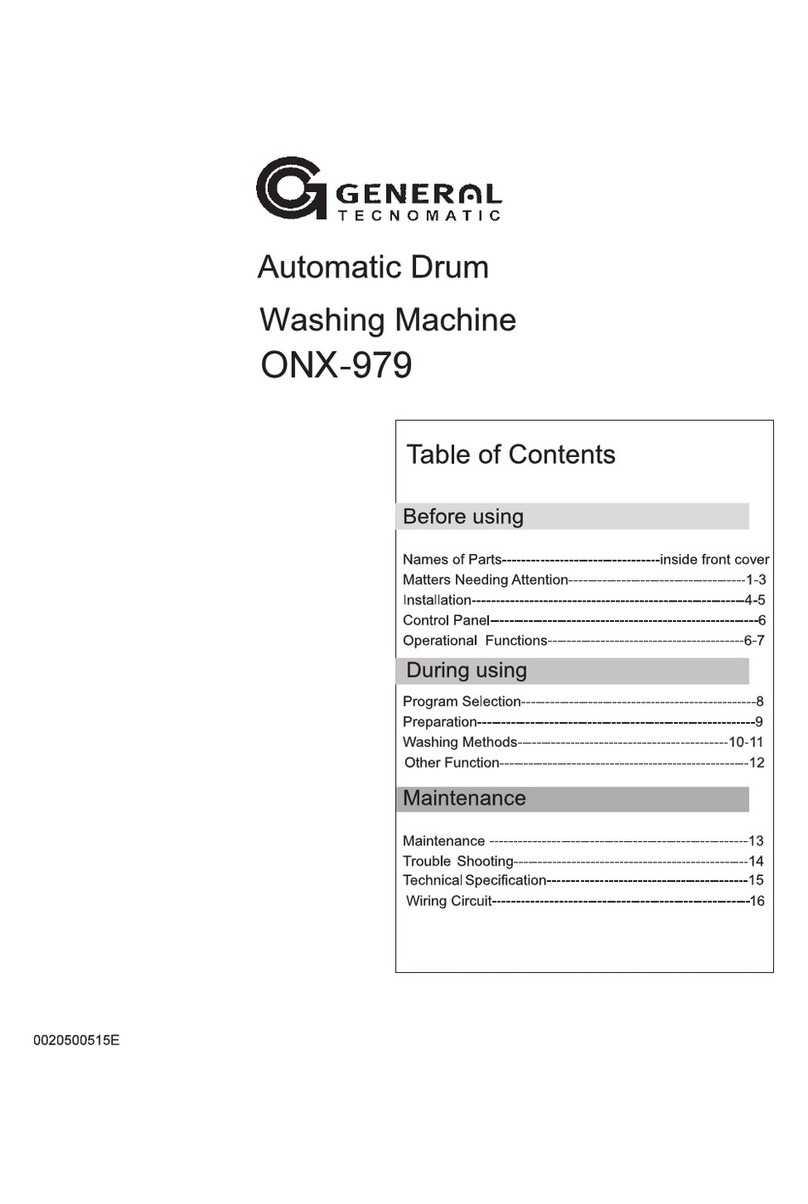
General Technomatic
General Technomatic ONX-979 user guide

GE
GE GNW128P Owner's Manual & Installation Instructions

Maytag
Maytag MTW6300TQ Bravos Service manual

Bosch
Bosch WAU28460ID Instruction manual and installation instructions




